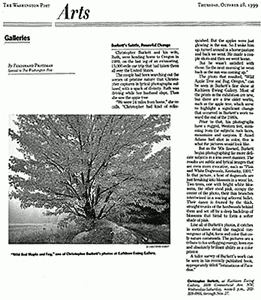Burkett's Subtle, Powerful Change

A Washington Post Article - October 28, 1999 by Ferdinand Protzman
Christopher Burkett and his wife, Ruth, were heading home to Oregon in1989, on the last leg of an exhausting, 15,000-mile car trip that had taken them all over the United States.
The couple had been searching out the scenes of pristine nature that Christopher captures in lyrical photographs suffused with a spark of divinity. Ruth was driving while her husband slept. Then she saw the apple tree.
“We were 14 miles from home,” she recalls “Christopher had kind of relinquished. But the apples were just glowing in the sun. So I woke him up, turned around in a horse pasture and back we went. He made a couple shots and then we went home, but he wasn’t satisfied with those. So the next morning he went back as the sun was coming up.”
The photo that resulted, “Wild Apple Tree and Fog, Oregon,” can be seen in Burkett’s fine show at Kathleen Ewing Gallery. Most of the prints in the exhibition are new, but there are a few old works, such as the apple tree, which serve to highlight a significant change that occurred in Burkett’s work towards the end of the 1980’s.
Prior to that, his photographs have a rugged, Western feel, stemming from the subjects: rock faces, mountains and canyons. If Ansel Adams had shot in color, this is what the pictures would look like.
But as the ’90s dawned, Burkett began photographing far more delicate subjects in a less overt manner. The results are subtle and lyrical images that are even more evocative, such as “Pink and White Dogwoods, Kentucky, 1991.” In that picture, a host of dogwoods are just breaking into blossom in a wood lot. Two trees, one with bright white blossoms, the other vivid pink, occupy the center of the photo, their thin branches intertwined in a soaring arboreal ballet. Their dance is framed by the thick, straight trunks of the hardwoods behind them and set off by a deep backdrop of blossoms that blend to form a softer shade of pink.
Like all of Burkett’s photos, it catches in meticulous details the magical convergence of light, form and color that only nature commands. The pictures are a tribute to his unflagging energy, keen eye and absolutely brilliant ability as a color printer.
A fuller survey of Burkett’s work can be seen in his recently published book, appropriately titled “Intimations of Paradise.”
Christopher Burkett, at Kathleen Ewing Gallery, 1609 Connecticut Ave. NW, Wednesday-Saturday, noon-5 p.m., 202-328-0955, through November 27, 1999.